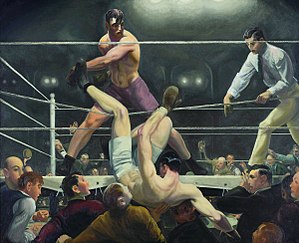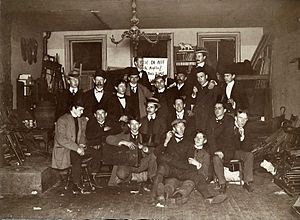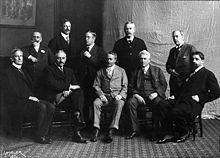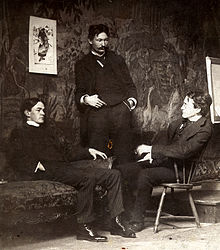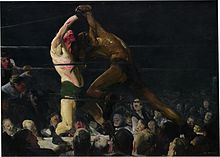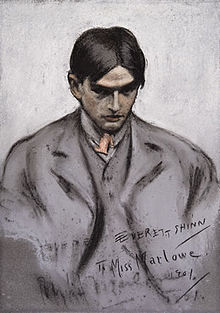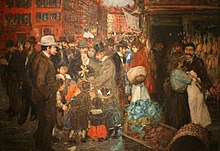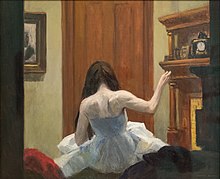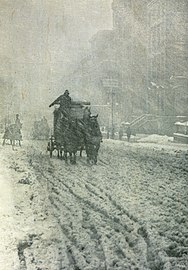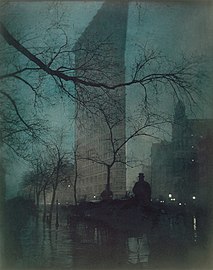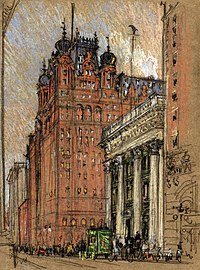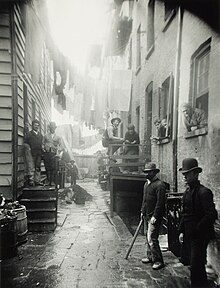
Edward Hopper was an American realist painter and printmaker. While he is widely known for his oil paintings, he was equally proficient as a watercolorist and printmaker in etching. Hopper created subdued drama out of commonplace subjects 'layered with a poetic meaning', inviting narrative interpretations. He was praised for "complete verity" in the America he portrayed. His career benefited decisively from his marriage to fellow-artist Josephine Nivison, who contributed much to his work, both as a life-model and as a creative partner.

Visual art of the United States or American art is visual art made in the United States or by U.S. artists. Before colonization there were many flourishing traditions of Native American art, and where the Spanish colonized Spanish Colonial architecture and the accompanying styles in other media were quickly in place. Early colonial art on the East Coast initially relied on artists from Europe, with John White the earliest example. In the late 18th and early 19th centuries, artists primarily painted portraits, and some landscapes in a style based mainly on English painting. Furniture-makers imitating English styles and similar craftsmen were also established in the major cities, but in the English colonies, locally made pottery remained resolutely utilitarian until the 19th century, with fancy products imported.

Social realism is the term used for work produced by painters, printmakers, photographers, writers and filmmakers that aims to draw attention to the real socio-political conditions of the working class as a means to critique the power structures behind these conditions. While the movement's characteristics vary from nation to nation, it almost always utilizes a form of descriptive or critical realism.

Stuart Davis, was an early American modernist painter. He was well known for his jazz-influenced, proto-pop art paintings of the 1940s and 1950s, bold, brash, and colorful, as well as his Ashcan School pictures in the early years of the 20th century. With the belief that his work could influence the sociopolitical environment of America, Davis' political message was apparent in all of his pieces from the most abstract to the clearest. Contrary to most modernist artists, Davis was aware of his political objectives and allegiances and did not waver in loyalty via artwork during the course of his career. By the 1930s, Davis was already a famous American painter, but that did not save him from feeling the negative effects of the Great Depression, which led to his being one of the first artists to apply for the Federal Art Project. Under the project, Davis created some seemingly Marxist works; however, he was too independent to fully support Marxist ideals and philosophies.

George Benjamin Luks was an American artist, identified with the aggressively realistic Ashcan School of American painting.

John French Sloan was an American painter and etcher. He is considered to be one of the founders of the Ashcan school of American art. He was also a member of the group known as The Eight. He is best known for his urban genre scenes and ability to capture the essence of neighborhood life in New York City, often observed through his Chelsea studio window. Sloan has been called the premier artist of the Ashcan School, and also a realist painter who embraced the principles of Socialism, though he himself disassociated his art from his politics.

The Ashcan School, also called the Ash Can School, was an artistic movement in the United States during the late 19th-early 20th century that produced works portraying scenes of daily life in New York, often in the city's poorer neighborhoods.
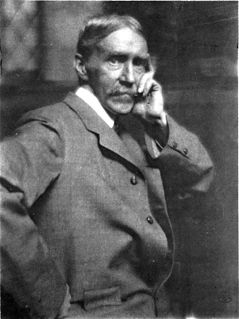
Maurice Brazil Prendergast was an American artist who painted in oil and watercolor, and created monotypes. His delicate landscapes and scenes of modern life, characterized by mosaic-like color, are generally associated with Post-Impressionism. Prendergast, however, was also a member of The Eight, a group of early twentieth-century American artists who, aside from Prendergast, represented the Ashcan School.
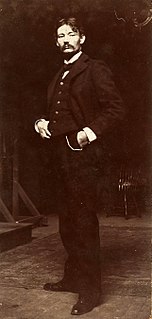
Robert Henri was an American painter and teacher.

William James Glackens was an American realist painter and one of the founders of the Ashcan School, which rejected the formal boundaries of artistic beauty laid-down by the conservative National Academy of Design. He is also known for his work in helping Albert C. Barnes to acquire the European paintings that form the nucleus of the famed Barnes Foundation in Philadelphia. His dark-hued, vibrantly painted street scenes and depictions of daily life in pre-WW I New York and Paris first established his reputation as a major artist. His later work was brighter in tone and showed the strong influence of Renoir. During much of his career as a painter, Glackens also worked as an illustrator for newspapers and magazines in Philadelphia and New York City.

Ernest Lawson was a Canadian-American painter and exhibited his work at the Canadian Art Club and as a member of the American group The Eight, artists who formed a loose association in 1908 to protest the narrowness of taste and restrictive exhibition policies of the conservative, powerful National Academy of Design. Though Lawson was primarily a landscape painter, he also painted a small number of realistic urban scenes. His painting style is heavily influenced by the art of John Henry Twachtman, J. Alden Weir, and Alfred Sisley. Though considered a Canadian-American Impressionist, Lawson falls stylistically between Impressionism and realism.

Everett Shinn was an American painter and member of the urban realist Ashcan School.

Genre painting, a form of genre art, depicts aspects of everyday life by portraying ordinary people engaged in common activities. One common definition of a genre scene is that it shows figures to whom no identity can be attached either individually or collectively, thus distinguishing it from history paintings and portraits. A work would often be considered as a genre work even if it could be shown that the artist had used a known person—a member of his family, say—as a model. In this case it would depend on whether the work was likely to have been intended by the artist to be perceived as a portrait—sometimes a subjective question. The depictions can be realistic, imagined, or romanticized by the artist. Because of their familiar and frequently sentimental subject matter, genre paintings have often proven popular with the bourgeoisie, or middle class.

Guy Pène du Bois was a 20th-century American painter, art critic, and educator. Born in the U.S. to a French family, his work depicted the culture and society around him: cafes, theatres, and in the twenties, flappers.

Mary (May) Wilson Watkins Preston was an American illustrator of books and magazines and an impressionist painter. She had an interest in art beginning in her teenage years, but her parents sent her to Oberlin College hoping that she would develop another interest. After three years, and at the urging of one of her teachers, Preston's parents allowed her to return to New York and attend the Art Students League. She then studied in Paris with James Whistler and next at the New York School of Art with William Merritt Chase.

Realism was an artistic movement that emerged in France in the 1840s, around the 1848 Revolution. Realists rejected Romanticism, which had dominated French literature and art since the early 19th century. Realism revolted against the exotic subject matter and the exaggerated emotionalism and drama of the Romantic movement. Instead, it sought to portray real and typical contemporary people and situations with truth and accuracy, and not avoiding unpleasant or sordid aspects of life. The movement aimed to focus on unidealized subjects and events that were previously rejected in art work. Realist works depicted people of all classes in situations that arise in ordinary life, and often reflected the changes brought by the Industrial and Commercial Revolutions. Realism was primarily concerned with how things appeared to the eye, rather than containing ideal representations of the world. The popularity of such "realistic" works grew with the introduction of photography—a new visual source that created a desire for people to produce representations which look objectively real.
James Moore Preston (1873–1962) was an American painter and illustrator, married to fellow artist May Wilson Preston. He was one of the Ashcan School, along with his friend, William Glackens.
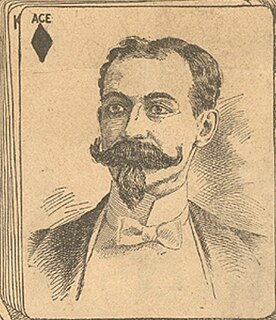
Merton Clive Cook, also known as Merton Clivette, was an American painter, magician, writer, vaudevillian and entertainer who spent most of his early life traveling the world entertaining before settling in New York to paint permanently. As a very highly regarded American artist of the early 20th century by his peers, his style can be identified with the American expressionist movement. Clivette is also known to be one of several artists who most defined the Ashcan realism period in New York at that time. Clivette was demonstrated artistic talent painting in a free flowing manner rarely painting over a line twice. During the 1920s his style evolved as he moved from realism toward expressionism eventually moving on to figurative and the abstract.

The Wrestlers is a 1905 oil painting by George Luks held at the Museum of Fine Arts, Boston in Massachusetts, United States. The Wrestlers is Luks' best-known work. The painting depicts two nude men wrestling. He painted it in order to shock members of the Pennsylvania Academy of the Fine Arts whom he called "pink-and-white idiots". The Wrestlers was displayed at the 1908 Ashcan School exhibition. A 1910 article in New York World about the Exhibition of Independent Artists included an image of Luks' The Wrestlers despite the fact that the painting did not appear in that exhibition. In a 1908 diary entry, painter John French Sloan writes that The Wrestlers is among the best paintings he ever encountered. In 1992, art critic Carol Clark identified The Wrestlers as one of Luks' best works, calling it "raw, roughly painted" and reflective of Luks' experiences in New York. In 1996, Allen Guttmann compared Luks' The Wrestlers to Thomas Eakins' Wrestlers and Max Slevogt's Wrestling School, writing that all three paintings depict pairs of nude wrestling men lying on the ground in grappling holds. In the 2009 Dictionary of Modern and Contemporary Art, Ian Chilvers and John Glaves-Smith write that The Wrestlers emulates the "bravura painterly technique of artists such as Manet".

The Macbeth Gallery was an art gallery in New York City that was the first to specialize in American art. Founded by William Macbeth in 1892, the gallery gained notoriety in 1908 when it put on an exhibition protesting the restrictive policies and conservative tastes of the existing art establishment in New York, exemplified by the National Academy of Design. The exhibition showcased the work of eight artists who were known for portraying gritty scenes of daily life, especially of poorer communities in New York: Robert Henri, William Glackens, George Luks, Everett Shinn, John Sloan, Arthur Bowen Davies, Ernest Lawson, and Maurice Prendergast. Though they had varying styles, the artists were later known collectively as "The Eight". Henri, Glackens, Luks, Shinn, and Sloan were associated with the Ashcan School, and the 1908 exhibition brought increased national attention to that movement and founded their reputations.
